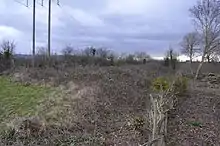Cropthorne New Inn Section
Cropthorne New Inn Section is a 0.12-hectare (0.30-acre) geological Site of Special Scientific Interest in Cropthorne in Worcestershire.[1][2] It is a Geological Conservation Review site.[3]
| Site of Special Scientific Interest | |
 | |
| Location | Worcestershire |
|---|---|
| Grid reference | SO996443 |
| Interest | Geological |
| Area | 0.12 hectares |
| Notification | 1991 |
| Location map | Magic Map |
The site dates to the Ipswichian interglacial (Marine Isotope Stage 5e) between 130,000 and 115,000 years ago. This was one of the warmest periods of the last half a million years, but there were no humans in Britain. The site has a rich array of mollusc and mammal fossils, including hippopotamus. There are a number of terraces of the River Avon laid down at different periods, and New Inn is a key site for determining their sequence, and for the Pleistocene stratigraphy of the Midlands generally.[1][4][5]
There is no public access to the site, which is a triangular area of scrub north of Main Road near the New Inn.
See also
References
- "Cropthorne New Inn Section citation" (PDF). Sites of Special Scientific Interest. Natural England. Archived from the original (PDF) on 8 January 2015. Retrieved 30 March 2015.
- "Map of Cropthorne New Inn Section". Sites of Special Scientific Interest. Natural England. Retrieved 30 March 2015.
- "Cropthorne, New Inn Section (Quaternary of Midlands - Avon)". Joint Nature Conservation Committee. Retrieved 30 March 2015.
- Pettit, Paul; White, Mark (2012). The British Palaeolithic: Human Societies at the Edge of the Pleistocene World. Abingdon, UK: Routledge. p. 291. ISBN 978-0-415-67455-3.
- Ashton, Nick; et al., eds. (2010). The Ancient Human Occupation of Britain. Elsevier. p. 128. ISBN 9780444535986.